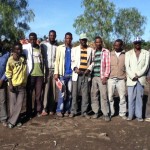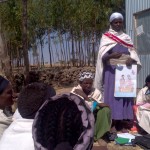
July 2014—Rather than pursue a risky migration abroad, or simply become resigned to a life of extreme poverty, landless youth in a chronically food insecure district in Ethiopia are staying in their families’ villages, while also earning an income. How?
In Ethiopia, 7.37 million people living with disabilities face challenges related to discrimination, exclusion from mainstream society, and extreme poverty. In addition, the physical environment is hostile to people with disabilities, including inaccessible roads and few sidewalks anywhere in the city, ill-equipped transportation, schools, housing, workplaces and public facilities.
With some 80 different ethnic groups and approximately 90 million people, providing quality education is the single biggest challenge and priority for Ethiopia’s Ministry of Education. A USAID-supported Early Grade Reading Assessment performed in 2010 revealed shockingly poor results in reading achievement. By the end of grade two, 34 percent of students were unable to read even one word and 48 percent of students scored a zero in comprehension. Teachers were not adequately trained to teach in ways that promote student learning. The lack of curriculum and textbooks, teacher’s guides, and supplemental reading materials exacerbated the low levels of achievement.

In Ethiopia, it is common for children to go to sleep hungry. Food insecurity is high among rural areas, and over 20 percent of children under 5 suffer from chronic malnutrition.
For many people in rural areas of Ethiopia access to sufficient water and adequate sanitation remains out of reach. Pastoralist communities in Ethiopia have some of the lowest water and sanitation coverage rates in the world, a situation exacerbated by climate change and population growth.
USAID interventions in areas of chronic and emergency water, sanitation, and hygiene (WASH) needs and subsequent development investments in sustainable access to safe water represent a success in moving families from relief to development programming.








Comment
Make a general inquiry or suggest an improvement.